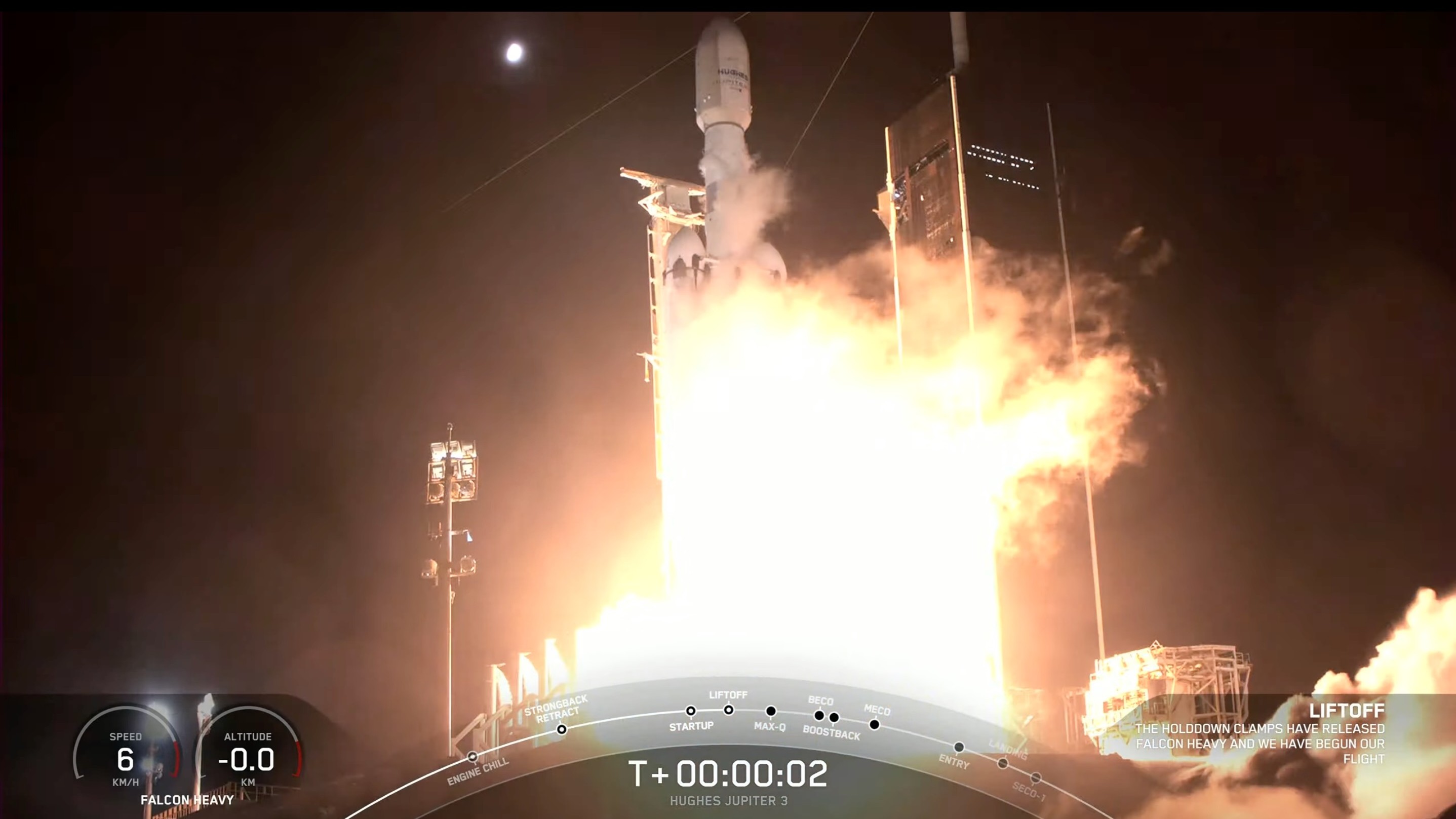SpaceX's Falcon Heavy rocket launches giant satellite, aces double booster landing
SpaceX's brawny Falcon Heavy rocket launched for the seventh time ever Friday night (July 28), sending a huge communications satellite skyward.
The Falcon Heavy lifted off Friday at 11:04 p.m. EDT (0304 GMT on July 29) from Pad 39A at NASA's Kennedy Space Center (KSC) in Florida, carrying the Jupiter 3 satellite skyward.
The launch kicked off a record-breaking mission: Jupiter 3 is the largest commercial communications satellite ever built, according to its operator, Hughes Network Systems.
Related: SpaceX launches 3 satellites to orbit on 6th-ever Falcon Heavy mission
The Falcon Heavy is the second-most powerful rocket flying today, after NASA's Space Launch System rocket, which debuted in November on the agency's Artemis 1 moon mission. (SpaceX's Starship vehicle is more powerful than the SLS but is not yet operational.)
The Heavy consists of three strapped-together first stages of the company's workhorse Falcon 9 rocket, with the central booster topped by an upper stage and the payload.
These first stages are designed to be reusable, and two of the ones that launched Friday could fly again: SpaceX landed the side boosters about 7.5 minutes after liftoff at Cape Canaveral Space Force Station, which is next door to KSC. The central booster, however, didn't have enough fuel left over for the return trip and ditched into the ocean after launch.
Breaking space news, the latest updates on rocket launches, skywatching events and more!
That latter detail speaks to the immense size of Jupiter 3 and how far away it's headed — toward geostationary orbit (GEO), which lies about 22,200 miles (35,700 kilometers) above Earth.
The satellite, which was built by Maxar Technologies and will service customers in the United States and Latin America, was deployed as planned about 3.5 hours after liftoff, SpaceX confirmed via social media. Jupiter 3 weighs 10.1 tons (9.2 metric tons), making it heavier than any payload ever launched toward GEO. When fully deployed, Jupiter 3 will feature a wingspan similar to that of a commercial airliner, according to Hughes.
The Falcon Heavy launched for the first time in February 2018, sending Elon Musk's red Tesla Roadster aloft on a highly anticipated and very photogenic test flight. It flew again in April 2019 and June 2019 but then endured a 40-month dry spell caused primarily by delays in the development of the satellites it was slated to carry.
But the Heavy is now picking up the pace. Friday's liftoff was the rocket's fourth in the past eight months, after launches in November 2022 and January and May of this year.
Jupiter 3 was originally supposed to go up on Wednesday night (July 26), but SpaceX scrubbed the try with 65 seconds left on the countdown clock "due to a violation of abort criteria." The company nixed another planned try on Thursday (July 27), citing a desire to "complete vehicle checkouts."
Editor's note: This story was updated at 11:40 p.m. ET on July 26 with news of that night's scrub and the new target date of July 27, then again at 5:30 p.m. ET on July 27 with news of the new target date of July 28. It was updated again at 11:27 p.m. ET on July 28 with news of successful liftoff and booster landings, then again at 11:48 a.m. ET on July 29 with news of satellite deployment.

Michael Wall is a Senior Space Writer with Space.com and joined the team in 2010. He primarily covers exoplanets, spaceflight and military space, but has been known to dabble in the space art beat. His book about the search for alien life, "Out There," was published on Nov. 13, 2018. Before becoming a science writer, Michael worked as a herpetologist and wildlife biologist. He has a Ph.D. in evolutionary biology from the University of Sydney, Australia, a bachelor's degree from the University of Arizona, and a graduate certificate in science writing from the University of California, Santa Cruz. To find out what his latest project is, you can follow Michael on Twitter.

